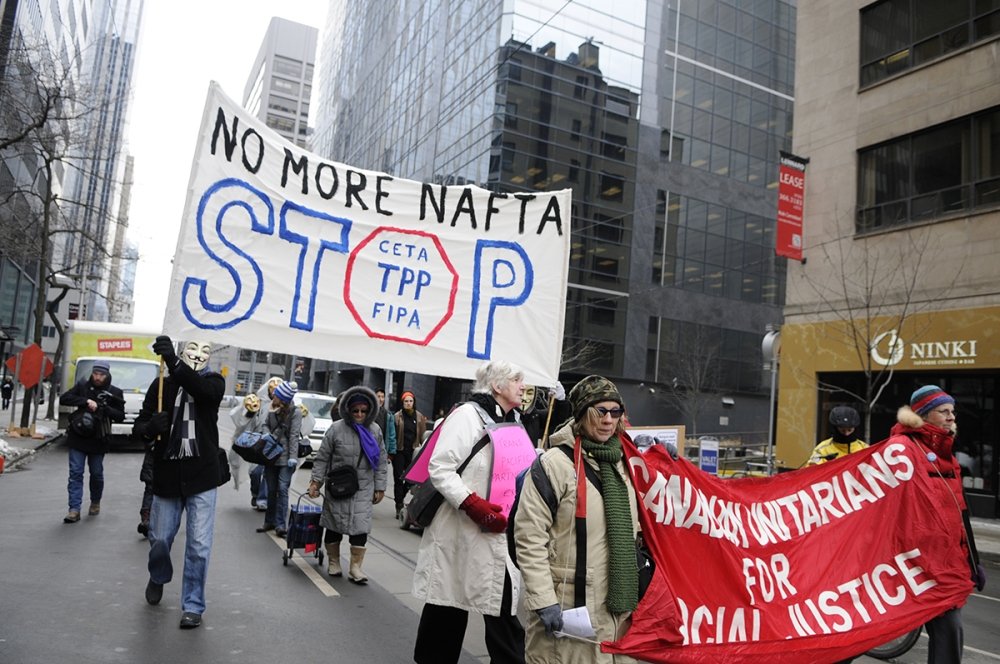
A blog of the Wilson Center
And After Free Trade?

Liu zishan/Shutterstock.com
President Biden will be the first US president since Jimmy Carter to neither negotiate nor sign a free trade agreement.
Less than five years ago, the United States-Mexico-Canada Agreement on Trade (USMCA) passed Congress with more recorded bipartisan votes than any other free trade agreement (FTA) in history. And yet, it’s highly unlikely any new agreements will be approved any time soon. It’s hard to overstate how dramatic a policy shift this is for the US. For more than three decades, the pursuit of freer trade has been on the to-do list of presidents and congressmen from both political parties.
When President Reagan signed his bilateral trade deal with Israel—America’s first-ever comprehensive free trade agreement—he said he hoped it would “stand as a model of the close cooperation between the administration and the Congress that can bring about a result benefiting all Americans.” Heritage Foundation Policy Analyst Edward Hudgins wrote glowingly at the time of both free trade and this agreement, and predicted the Israel FTA would significantly benefit both countries.
When President Clinton signed the North American Free Trade Agreement (NAFTA), which created what was then the world’s largest free trade zone, he proclaimed, “We seek a new and more open global trading system not for its own sake, but for our own sake (emphasis added).” By the time he left office, Clinton had signed 300 smaller trade agreements which he pointed to as contributing to the growth of US exports by 74% between 1992 and 2000.
President George W. Bush grew the number of comprehensive bilateral FTAs from 3 to 16, and credited them with growing US exports in goods and services by more than 50%. He was clear voiced in his support for trade, stating in his administration’s national security strategy, “Free trade and free markets have proven their ability to lift whole societies out of poverty—so the United States will work with individual nations, entire regions, and the entire global trading community to build a world that trades in freedom and therefore grows in prosperity.”
Under President Obama, Congress approved FTAs with South Korea, Colombia, and Panama by wide bipartisan margins. The agreement with Colombia, which saw the closest vote of the three, still passed the Senate on a 2-to-1 vote. As trade officials moved toward implementation, Obama said, "This agreement… is a win for the United States by increasing our exports by more than $1 billion, supporting thousands of US jobs and helping to achieve my goal of doubling US exports. It's a win for Colombia by giving you even greater access to the largest market for your exports: the United States of America."
And yet, it was also during the Obama years that trade’s political winds began to shift. At first, the Obama administration saw an opportunity to reshape America’s economic presence and leadership in Asia and the Pacific Rim through the multilateral Trans-Pacific Partnership (TPP). After all, the 12 signatories to the TPP framework (which included the US) represented nearly 40% of the global economy. In an essay published by The Washington Post, President Obama asserted that, “Once the TPP is in place, American businesses will export more of what they make. And that means supporting more higher-paying jobs.” He also wrote, “When fewer people suffer in poverty, when our trading partners flourish, and when we bind our economy closer to others in a strategically important region, America is both stronger and safer.” He summed things up by arguing that America’s competitors were pursuing trade opportunities with or without the US and, therefore, TPP was about ensuring that “America, not China, [would] lead the way on global trade.”
Of course, TPP was never to be. Despite President Obama’s push, it became clear that opposition to free trade (and globalization) was on the rise. Even between 2000 and 2008, when President George W. Bush was full-throated in his support for trade, only an average of 53% of Republicans and 47% of Democrats held positive opinions about using trade as a tool for American economic growth. By 2016, according to a CBS News poll, 75% of self-identified Trump voters and 48% of Clinton voters said they thought trade with other countries cost America jobs. Both Trump and Clinton opposed TPP.
So where does the failure of TPP and other trade proposals leave the trade community?

Shutterstock/arindambanerjee.
Many of our trading partners are moving on without us. The nations that previously supported TPP joined together to form the Comprehensive and Progressive Agreement for Trans-Pacific Partnership (CPTPP), which the US has shunned. Canada, Australia, Chile, Japan, Mexico, Malaysia, Peru, Vietnam, and Singapore have all signed onto CPTPP—countries making up nearly 14% of the global economy. Sensing a political opportunity, if not an economic one, Beijing has made clear that it, too, would like to join CPTPP.
For many Republicans, the pursuit of free trade is gradually being replaced with what Robert Lighthizer, former US Trade Representative, has coined “balanced trade”—a focus on eliminating our trade deficit (the difference between our exports and imports) with each of our partners where possible. Lighthizer argues that the balanced trade approach would work to strengthen priority sectors in our domestic economy. In its 2024 party platform, the Republican National Committee states, “We commit to rebalancing trade, securing strategic independence, and revitalizing manufacturing. We will prioritize domestic production and ensuring national independence in essential goods and services.” Notably, when President Trump proudly announced the completion of USMCA negotiations, he deemed it “the largest, most significant, modern, and balanced trade agreement in history (emphasis added).”
For many Democrats, the support for free trade that characterized the Clinton administration is being replaced with an emphasis on “friendshoring” and “nearshoring.” Katherine Tai, our current US Trade Representative, has argued that traditional FTAs simply enable corporations to find “cheap labor abroad” at the expense of American workers and national security. This new approach emphasizes policies which control our technology trade with China and fosters trade with allies in the clean energy supply chain and in cutting-edge tech sectors. The Biden administration’s National Security Strategy, released in late 2022, states, “We are complementing the innovative power of the private sector with a modern industrial strategy that makes strategic public investments in our workforce, strategic sectors, and supply chains, especially in critical and emerging technologies.” In practical terms, this has meant putting FTA negotiations with Kenya and the United Kingdom on the back burner, and instead emphasizing non-tariff agreements like the Indo-Pacific Economic Framework for Prosperity and The Americas Partnership for Economic Prosperity.
As Washington debates the best ways to strengthen US economic leadership and open new markets, Beijing continues to actively pursue new trade deals wherever it can. In addition to asking to join CPTPP, China has been pursuing trade agreements with Sri Lanka, Moldova, and Israel, among others.
In the free trade era, Ronald Reagan once said, “Nothing better demonstrates the shared community of aspirations between our nations than our promotion of free and harmonious trade for our mutual benefit.” The world has obviously changed dramatically since the days of Reagan, and American leaders—in both parties—have changed their approach to economic statecraft and leadership.
China is betting that the world still wants new trade deals and opportunities. America seems to be betting that the world will settle for other approaches and alternatives. We’d better get this right.
This blog was researched and drafted with assistance from Katherine Schauer and Camilla Reitherman.
About the Author


Wahba Institute for Strategic Competition
The Wahba Institute for Strategic Competition works to shape conversations and inspire meaningful action to strengthen technology, trade, infrastructure, and energy as part of American economic and global leadership that benefits the nation and the world. Read more













